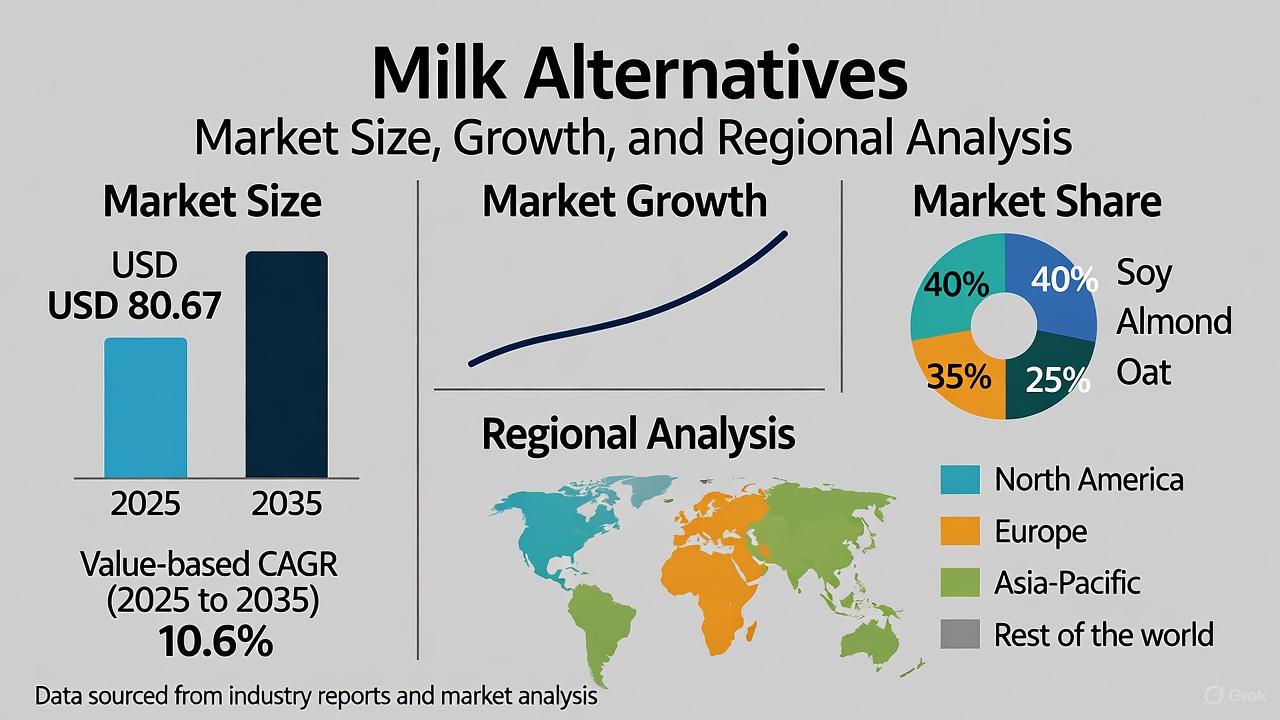Milk Alternatives Market to Surpass USD 80.67 Billion by 2035

The global Milk Alternatives Market is projected to grow from USD 32.25 billion in 2025 to an impressive USD 80.67 billion by 2035, expanding at a CAGR of 10.6%. This remarkable growth is being driven by the rising global shift toward plant-based diets, environmental awareness, and continuous product innovation by both established brands and emerging manufacturers.
Industry Growth Driven by Health and Sustainability Trends
Milk alternatives—such as almond, soy, oat, coconut, and rice milk—have evolved from niche products into mainstream dietary staples. Consumers are increasingly choosing these options not just for lactose intolerance or vegan preferences, but also for their nutritional benefits and lower environmental footprint. As sustainability becomes a defining factor in purchasing decisions, plant-based milk brands are responding with eco-friendly packaging and responsible sourcing practices.
The growing vegan population, particularly in North America and Europe, is shaping consumption patterns and fueling demand for high-quality, dairy-free alternatives. Traditional dairy production’s heavy water usage and carbon emissions are prompting consumers to favor plant-based options that align with eco-conscious living.
Get this Report at $3500 Only (Report price) | Exclusive Discount Inside!: https://www.futuremarketinsights.com/reports/sample/rep-gb-19964
Market Challenges and Price Sensitivity
Despite the robust growth outlook, the industry faces challenges related to high production costs and retail pricing. The processing and raw material expenses of ingredients like almonds and oats often make plant-based milks more expensive than traditional dairy. For cost-sensitive markets, this price gap remains a key restraint to widespread adoption. However, increasing competition and scaling production are expected to gradually balance pricing, making these products more accessible in emerging economies.
Competitive Landscape: Leading and Emerging Innovators
The milk alternatives market is witnessing strong participation from both global giants and agile startups. Oatly, known for its oat-based milk, continues to expand internationally through strategic partnerships with coffee chains and fast-food brands. Its sustainability-driven marketing has set new benchmarks in the industry.
Alpro, under Danone, is broadening its portfolio across almond, soy, and oat varieties to cater to vegan and lactose-free consumers. Meanwhile, Blue Diamond Growers emphasizes the health benefits of almonds through its Almond Breeze range, while Silk—also a Danone subsidiary—focuses on product diversity, introducing soy, almond, and cashew options that combine taste and nutrition.
Emerging brands like Mooala and Ripple Foods are reshaping the market through innovation. Mooala’s organic almond-banana blends and Ripple’s pea-protein-based milks highlight how startups are meeting the growing demand for clean-label, sustainable products with unique nutritional profiles.
Regional Insights: Rapid Growth Across Key Economies
In Asia Pacific, countries such as India are leading growth with a projected CAGR of 15.9%. Urbanization, rising disposable incomes, and changing lifestyles are driving strong demand for soy, almond, and oat-based beverages.
In North America, the United States remains a dominant market, growing at 10.8% CAGR as awareness of lactose intolerance and dairy allergies increases. Health-conscious consumers are gravitating toward plant-based milks for their lower fat content and added nutritional value.
Across Europe, the United Kingdom is emerging as a sustainability leader in the market, also posting a 10.8% CAGR. Environmental considerations and a strong preference for low-carbon-footprint products are reshaping consumer habits, making plant-based milks a mainstream choice.
Trends Redefining the Milk Alternatives Industry
Flavor innovation and product diversification are among the most influential trends in this sector. The popularity of flavored milk alternatives, which hold a 28.5% market share, demonstrates growing consumer appetite for options like vanilla, chocolate, and matcha. Meanwhile, soy milk, accounting for 31.2% of the market, continues to lead the segment due to its protein content and affordability.
Sustainability is also emerging as a major differentiator. Manufacturers are transitioning toward recyclable packaging, transparent sourcing, and environmentally responsible production to attract eco-conscious consumers.
- Art
- Causes
- Crafts
- Dance
- Drinks
- Film
- Fitness
- Food
- Juegos
- Gardening
- Health
- Inicio
- Literature
- Music
- Networking
- Otro
- Party
- Religion
- Shopping
- Sports
- Theater
- Wellness


